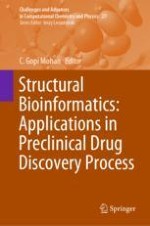Abstract
Structure-based in silico studies aiming to predict affinity of a set of ligands to their cognate receptor have been enjoying keen interest and attention of researchers in drug design around the globe since many decades, and made significant progress to increase its predictive power, even it has emerged as a complementary field to in vivo and in vitro studies in recent years. Structure-based drug discovery (SBDD) process whose success heavily relies on a careful selection of structure of receptor and ligands and its accuracy, completeness, and rigor of chosen model, imitation of the physiological condition in such in silico models, e.g., pH and solvation. Appropriateness of selected mechanism of binding concept and the realization in mathematical terms used in scoring methods have a strong influence on the accuracy too. However, constant identification of new targets using systems approach like genomics, proteomics, metabolomics, and network biology has led a paradigm shift from single or a couple of targets toward the appreciation of emerging role of a network of targets. The application of such strategies in study of complex diseases is gaining attention. Identification of binding sites of receptor and their characterization is important to be able to portray its interacting features. It involves the search of ligands which are able to possess the features, present them complementary to the binding site, so by docking the set of ligands to the binding pocket of the receptor, activity can be evaluated. In silico receptor–ligand binding affinity prediction from docking has witnessed rigid-receptor rigid-ligand to flexible-ligand rigid-receptor treatment, and nowadays docking studies, through sampling side chain rotations of the binding site residues, also account for the flexibility of binding pocket of the receptor in indirect way. Literature survey has shown progress in ranking ligands in order of affinity using reliable scoring functions to find potent scaffolds which can be further optimized to gain more affinity. Many methods include effect of solvation in binding processes, like considering conserved water positions in active sites (water maps), explicit water simulation in presence of ligand with receptor, free energy perturbation, and thermodynamic integration. Availability of many conformers of receptors and ligands in solution suggests the importance of entropy in estimation of binding affinity, but entropy component of binding free energy directly is not included in such studies. In spite of unprecedented advancement of computational modeling, faster simulation techniques, accurate solvation models and current best practices, the dependence of binding affinity on pH, estimation of entropy along with enthalpy in binding affinity, inclusion of conformational entropy of ligand and receptor, and modulation of flexibilities during complex formation are important challenges lying ahead. Therefore, an account of prowess and challenges in structure-based prediction of binding affinity addressed in present review will provide directions for its appropriate application, understanding its limitations and getting important feedbacks for its betterment.
